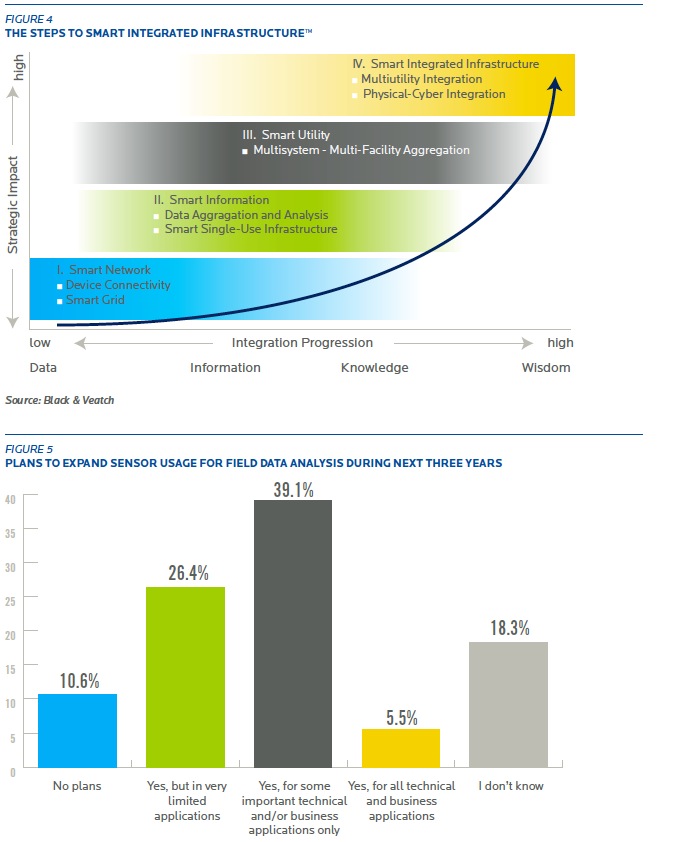BLACK & VEATCH
Executive Summary
By Fred Ellermeier
When the term “smart grid” first entered the common lexicon, it was used to describe a future state of electric utility distribution networks. This future state promised a grid that would have lower operational costs and be more reliable, more informative, better integrated and more efficient, among a long list of additional benefits.
Since the rollout of the first smart grid programs, there has been a realization that automation and “smart” programs benefit all types of utilities and infrastructure systems. Gas and water smart grids, for example, will result in more efficient storage, improved distribution, reductions in system losses and expanded customer engagement.
However, as noted in Black & Veatch’s 2011 Strategic Directions in the U.S. Electric Industry report, “divergent perspectives make the commitment to achieving smart grid opportunities more difficult to define, quantify and justify. Without common alignment of program objectives, approval from regulators, utility boards and consumer advocates becomes difficult.”
These concerns continue to resonate in 2014.
Black & Veatch believes that the objectives and priorities of all utility stakeholders can ultimately be achieved through a series of progressive improvements. These improvements go beyond a smart grid or utility distribution network. A Smart Utility™ integrates multiple systems, such as generation, distribution and demandside management, to reduce resource requirements and costs while enhancing reliability and performance.
Additionally, by not just making a smart grid, but a “smart utility,” currently siloed infrastructure systems, such as electric, water, gas and transportation, can work together seamlessly to create even greater value for a community and each other. In a real and tangible way, we can create Smart Integrated Infrastructure™ (Figure 4).
BUILDING ON DATA
The first step in creating Smart Integrated Infrastructure is creating a smart network. This network is generally referred to as a utility’s “smart grid” program and involves the deployment of a foundational communications infrastructure. This foundation provides the connectivity that enables smart meters, sensors and other devices across the utility enterprise. These devices can collect and transmit data to utility operators. As utilities deploy their foundational networks and advanced metering infrastructure (AMI) systems, they also seek additional applications to leverage the communications network and meter as a sensor.
The benefits realized by utilities that have fully implemented AMI programs have been compelling. NV Energy’s NVEnergize smart metering program, for example, has resulted in annualized operational savings of $35 million. Smart meters for water utilities eliminate the need to estimate customer usage, making billing more efficient and accurate. Further, smart meters can facilitate better management of water resources, particularly during periods of drought. But regardless of utility type, all AMI programs generate data – and lots of it.
Utilities are also looking to expand data collection to include distribution and other assets, such as water treatment plants, pumps and transmission lines. More than 70 percent of all utilities plan to expand the use of sensors and other instrumentation to gather field data within the next three years (Figure 5).
Download full version (PDF): Utility Automation and Integration
About Black & Veatch
bv.com
“Black & Veatch started 1915 as a two-person partnership between former University of Kansas classmates Ernest Bateman Black and Nathan Thomas Veatch. The company began with 12 employees with offices in Kansas City, Missouri. It landed two large contracts, one in power and one in water, in its first year…Today, the company continues to experience strong growth across its core markets. Black & Veatch currently has a global workforce of more than 9,000 working in over 100 offices worldwide with projects completed in more than 100 countries on six continents.” – See more at: https://www.infrastructureusa.org/strategic-directions-in-the-north-american-natural-gas-industry/#sthash.n5f2FQuA.dpuf
Tags: Black & Veatch, Fred Ellermeier







 RSS Feed
RSS Feed